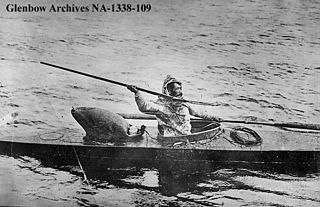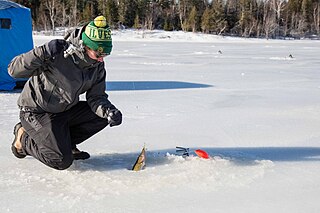
Fishing is the activity of trying to catch fish. Fish are often caught as wildlife from the natural environment, but may also be caught from stocked bodies of water such as ponds, canals, park wetlands and reservoirs. Fishing techniques include hand-gathering, spearing, netting, angling, shooting and trapping, as well as more destructive and often illegal techniques such as electrocution, blasting and poisoning.

Trolling is a method of fishing where one or more fishing lines, baited with lures or bait fish, are drawn through the water at a consistent, low speed. This may be behind a moving boat, or by slowly winding the line in when fishing from a static position, or even sweeping the line from side-to-side, e.g. when fishing from a jetty. Trolling is used to catch pelagic fish such as salmon, mackerel and kingfish.

A fishing line is any flexible, high-tensile cord used in angling to tether and pull in fish, in conjunction with at least one hook. Fishing lines are usually pulled by and stored in a reel, but can also be retrieved by hand, with a fixed attachment to the end of a rod, or via a motorized trolling outrigger.

Angling is a fishing technique that uses a fish hook attached to a fishing line to tether individual fish in the mouth. The fishing line is usually manipulated via a fishing rod, although rodless techniques such as handlining also exist. Modern angling rods are usually fitted with a fishing reel that functions as a cranking device for storing, retrieving and releasing out the line, although Tenkara fishing and traditional cane pole fishing are two rod-angling methods that do not use any reel. The fish hook itself can be additionally weighted with a denser tackle called a sinker, and is typically dressed with an appetizing bait to attract and entice the fish into swallowing the hook, but sometimes an inedible fake/imitation bait with multiple attached hooks is used instead of a single hook with edible bait. Some type of bite indicator, such as a float, a bell or a quiver tip, is often used to relay underwater status of the hook to the surface and alert the angler of a fish's presence.

A harpoon is a long spear-like projectile used in fishing, whaling, sealing, and other hunting activities to shoot, kill, and capture large fish or marine mammals such as seals, sea cows and whales. It accomplishes its task by impaling the target animal and securing it with barb or toggling claws, allowing the fishermen or hunters to use an attached rope or chain to pull and retrieve the animal. A harpoon can also be used as a ranged weapon against other watercraft in naval warfare.

Spearfishing is fishing using handheld elongated, sharp-pointed tools such as a spear, gig, or harpoon, to impale the fish in the body. It was one of the earliest fishing techniques used by mankind, and has been deployed in artisanal fishing throughout the world for millennia. Early civilizations were familiar with the custom of spearing fish from rivers and streams using sharpened sticks.

Ice fishing is the practice of catching fish with lines and fish hooks or spears through an opening in the ice on a frozen body of water. Ice fishers may fish in the open or in heated enclosures, some with bunks and amenities.

Esox is a genus of freshwater fish commonly known as pike or pickerel. It is the type genus of the family Esocidae. The type species of the genus is Esox lucius, the northern pike.

A speargun is a ranged underwater fishing device designed to launch a tethered spear or harpoon to impale fish or other marine animals and targets. Spearguns are used in sport fishing and underwater target shooting. The two basic types are pneumatic and elastic. Spear types come in a number of varieties including threaded, break-away and lined. Floats and buoys are common accessories when targeting larger fish.

A fishing lure is any one of a broad category of artificial angling baits that are inedible replicas designed to mimic prey animals that attract the attention of predatory fish, typically via appearances, flashy colors, bright reflections, movements, vibrations and/or loud noises which appeal to the fish's predation instinct and entice it into gulping the lure. Angling activities using lures are known as lure fishing.

A fish hook or fishhook, formerly also called angle, is a hook used to catch fish either by piercing and embedding onto the inside of the fish mouth (angling) or, more rarely, by impaling and snagging the external fish body. Fish hooks are normally attached to a line, which tethers the target fish to the angler for retrieval, and are typically dressed with some form of bait or lure that entices the fish to swallow the hook out of its own natural instinct to forage or hunt.

A pike pole is a long metal-topped wooden, aluminium or fiberglass pole used for reaching, hooking and/or pulling on another object. They are variously used in boating, construction, logging, rescue and recovery, power line maintenance, and firefighting.

Fishing tackle is the equipment used by anglers when fishing. Almost any equipment or gear used in fishing can be called fishing tackle, examples being hooks, lines, baits/lures, rods, reels, floats, sinkers/feeders, nets, spears, gaffs and traps, as well as wires, snaps, beads, spoons, blades, spinners, clevises and tools that make it easy to tie knots.
The Hawaiian sling is a device used in spearfishing. The sling operates much like a bow and arrow does on land, but energy is stored in rubber tubing rather than a wooden or fiberglass bow.

A fishing vessel is a boat or ship used to catch fish and other valuable nektonic aquatic animals in the sea, lake or river. Humans have used different kinds of surface vessels in commercial, artisanal and recreational fishing.

The food of the Tlingit people, an indigenous group of people from Alaska, British Columbia, and the Yukon, is a central part of Tlingit culture, and the land is an abundant provider. A saying amongst the Tlingit is that "When the tide goes out the table is set." This refers to the richness of intertidal life found on the beaches of Southeast Alaska, most of which can be harvested for food. Another saying is that "in Lingít Aaní you have to be an idiot to starve". Since food is so easy to gather from the beaches, a person who cannot feed himself at least enough to stay alive is considered a fool, perhaps mentally incompetent or suffering from very bad luck. Though eating off the beach could provide a fairly healthy and varied diet, eating nothing but "beach food" is considered contemptible among the Tlingit, and a sign of poverty. Shamans and their families were required to abstain from all food gathered from the beach, and men might avoid eating beach food before battles or strenuous activities in the belief that it would weaken them spiritually and perhaps physically as well. Thus for both spiritual reasons as well as to add some variety to the diet, the Tlingit harvest many other resources for food besides what they easily find outside their front doors. No other food resource receives as much emphasis as salmon; however, seal and game are both close seconds.

Fishing techniques are methods for catching fish. The term may also be applied to methods for catching other aquatic animals such as molluscs and edible marine invertebrates.
Destructive fishing practices are fishing practices which easily result in irreversible damage to habitats and the sustainability of the fishery ecosystems. Such damages can be caused by direct physical destruction of the underwater landform and vegetation, overfishing indiscriminate killing/maiming of aquatic life, disruption of vital reproductive cycles, and lingering water pollution.

Perahu payang or simply payang is a traditional Malay open fishing boat. They are usually found in Terengganu, and to a lesser extent, Kelantan, Pahang, and Johor coasts. A few examples normally come down to Singapore to operate during the period of the north-east monsoon in the South China Sea.




















